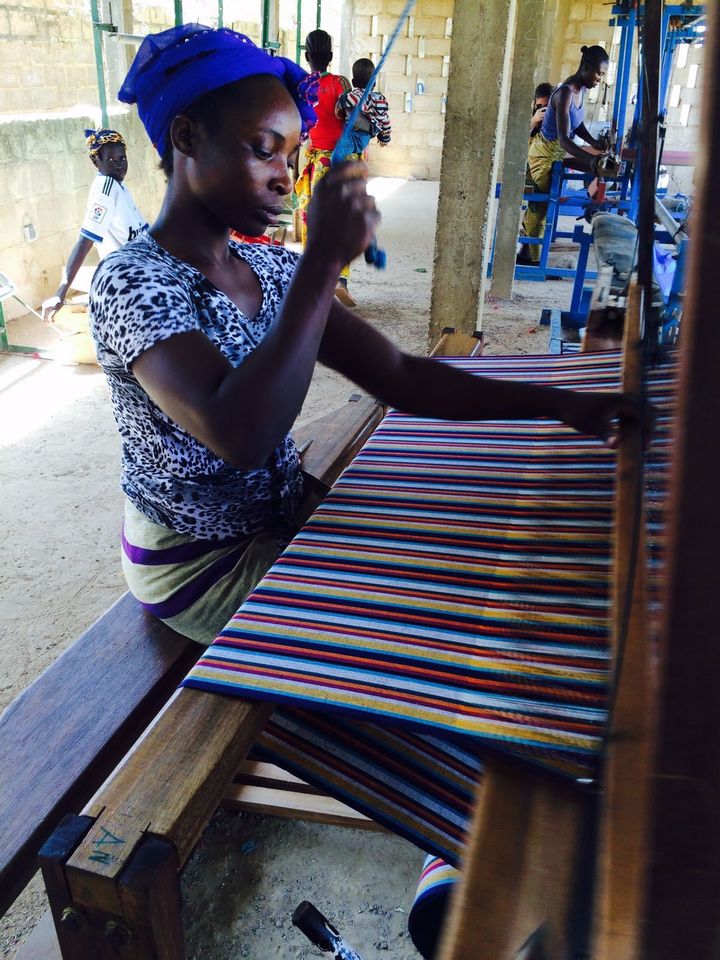
A regular day at CABES, a Cooperative of weavers in Burkina Faso where women have access to sustainable and dignified employment, and a strong sense of community-building
Typically, analysis explains migration in terms of the income gaps between societies: people from low-income countries move to higher income societies with the hope of having more opportunities. This link was statistically proven by the World Bank’s seminal study on migration.
By this token, one would think increasing income in poorer countries would automatically curb migration. However, this is not entirely true, because higher incomes alone are not enough to stop the migration dynamic. Why? Because migration is also a long-term investment that requires would-be migrants to have sufficient economic resources to migrate. And with higher incomes, migration actually becomes more affordable. Looking at the case of migration from Africa to Europe, we know the income gap with Europe has existed for a long time. But it is only recently that African economies have grown enough to see income trickle down to the informal sector. Approximately 75% of African workforce is employed in the informal sector, and for this section of the economy to grow, the overall wealth of a country must expand. Many forms of informal employment—caused by the lack of a structured economy and labor market—become available for the poor when an economy expands. In practical terms, this means revenues from sales of commodities and raw materials (in the form of growing exports from Africa) make a minority richer. This minority needs services and goods not available through established businesses. So, they go to informal artisans and workers to buy clothes and shoes, to get their houses cleaned, and so on. In turn, workers and artisans who get access to this market become richer, and get more services from the same informal network. This growth of income generates a nucleus of wealth.
Today, Africa is recording higher economic growth and thus the informal economy across many parts of the continent has had a recent boost in income availability. Partly as a result, migration has increased. Knowing that a journey to Europe costs between USD5000-10000 per person, aspiring migrants collect the money they need by borrowing in this informal sector, where income is available. Lenders supply the capital with the hope of establishing a bridgehead abroad to make migration easier for them one day. For them too, this loan represents a small investment. Not by chance, one of the factors associated with migration flows is the presence of a strong diaspora in the destination country.
The scheme above is highly simplified, but it helps explain why gaps in income are not the only factor. One of the main factors to explain migration, as Paul Collier has written in his beautiful and clever book, is the difference in social models. There are societies in which good institutions, a common sense of purpose shared by the population and those communities see different attitudes towards cooperation, reduced conflict and more opportunities. These societies, usually richer societies, enable people to become productive and protect the outcome of their efforts. Migrants are attracted by them and by choosing to leave, they are also voting for a different social model. They want to live in a place where the state is trusted and where relationships are regulated by a shared set of juridical and behavioral norms.
As such, an effective policy on migration should not only work to reduce income gaps, but also create conditions for a more stable, peaceful, trust driven society—for, in essence, better social capital and the rule of law. These factors can produce a social model that they can find at home, and doesn’t require them to go abroad to find it.
I want to express this with another example: the program I founded and run is helps to strengthen social trust by providing market access and creating jobs for cooperatives of weavers in Burkina Faso and Mali. The outcome of this initiative—recorded in qualitative and quantitative impact assessments—is an increase in incomes, of course, but also more trust in the future and thus better collaborative attitudes. Communities that experience this are stronger, and its members are willing to invest to develop this work further, as they have a sense of community and feel confident about their future.
This kind of work doesn’t only transfer funds to the communities in which we work, but also transfers the idea that working together improves life. This on-the-ground community development must also be accompanied by the development of institutions that make this trust permanent, by guaranteeing people protection from abuse and violence. In this sense, the recent peace agreement enabled by the Italian Government with 60 tribes in southern Libya is a good example of institutional trust building.
Addressing migration is about promoting the development of better social models more than simply raising income levels. It is also about questioning identities and patterns of openness in host countries. But it all starts when people feel they lack the economic AND social pathways to a better life.

Community leaders from various weaving groups in West Africa attending a monthly meeting to discuss the expansion of their network.